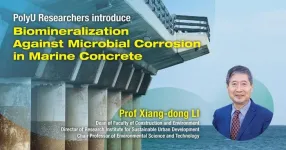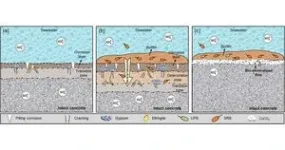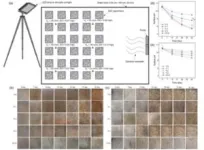(Press-News.org) Microbially induced corrosion (MIC) is a prevalent issue in marine environments, leading to structural damages such as cracking in concrete infrastructure. This corrosion poses a persistent challenge, significantly reducing the lifespan of marine structures and resulting in substantial economic losses. In response to the need for an effective solution to combat the marine corrosion on concrete, researchers of the Hong Kong Polytechnic University have developed a biomineralization approach to protect marine concrete from MIC.
Prof. Xiang-dong LI, Dean of Faculty of Construction and Environment, Director of Research Institute for Sustainable Urban Development, Chair Professor of Environmental Science and Technology, and Ko Jan Ming Professor in Sustainable Urban Development, has led the research that successfully introduces a novel biomineralization strategy, which effectively isolates marine concrete from MIC, thereby contributing to the achievement of sustainable coastal structures.
MIC on concrete usually occurs in harsh environments with the presence of corrosive microorganisms, such as sewage structures, wastewater treatment plants, and marine structures. The formation of a biomineralized film on concrete surfaces is typically considered to be the major anticorrosion mechanism as it can provide a barrier to inhibit corrosion.
Prof. LI said, “The biomineralization technique serves as an environmentally friendly coating method for controlling concrete corrosion, with minimal impact on the overall biofilm communities. Also, it utilises carbon dioxide to produce mineral precipitates, enhancing the durability of concrete structures. This process not only reduces the carbon footprint and energy consumption of marine infrastructure throughout its lifespan, but also makes a valuable contribution to carbon neutrality and sustainability.”
The study showed the biomineralization treatment effectively prevents corrosion by reducing the total and relative abundance of sulfate-reducing bacteria (SRB). SRB is a type of anaerobic bacteria and can produce hydrogen sulfide, which is corrosive and can lead to material deterioration.
The biomineralized film acts as a protective layer, controlling sulfate diffusion and isolating the concrete from the corrosive SRB communities. This protective mechanism significantly extends the lifespan of concrete structures. Moreover, this technique has no negative impact on the native marine microbial communities.
Prof. LI added, “If the biomineralized film remains intact, repainting the concrete structures is unnecessary. The utilisation of a single coating treatment eliminates the need for multiple treatments, further minimising the cost and carbon footprint.”
This biomineralization strategy has strong potential for applications in corrosive environments, such as marine environments, sewage environments, and water cooling utilities, where concrete corrosion is induced by corrosive microorganisms.
The research, titled “Biomineralization to prevent microbially induced corrosion on concrete for sustainable marine infrastructure” was published in Environmental Science & Technology. The study employed a combination of chemical and mechanical property measurements of concrete, along with an analysis of the microbial community of biofilms, to evaluate the effectiveness of biomineralization techniques in inhibiting corrosion of marine concrete. These assessments aimed to enhance understanding of MIC development. The results contribute to the development of new techniques for inhabiting corrosion to achieve sustainable marine concrete structures.
In a sulfate chemical attack, calcium hydroxide and calcium aluminate hydrate will be consumed to form gypsum and ettringite, resulting in expansion stress and matrix fracture (Figure 1a). In an MIC attack, bacteria can colonise the corroded layer, which provides an excellent medium for microorganisms to grow. Microbial activity can extend beyond the corrosion layer near to the surface and spread across the deterioration zone (Figure 1b). Compared with chemical corrosion, MIC causes more severe damage to marine concrete structures. However, the formation of the biomineralized film on the concrete surfaces led to higher surface pH (potential of hydrogen) and lower surface sulfate concentrations, which also acted as a protective layer to control the diffusion of sulfate and isolate the concrete from SRB communities, decreasing internal sulfate levels (Figure 1c).
Considering that the type of colonised surface also affects the treatment effect of biomineralization, the effectiveness of biomineralization will be further investigated for different types of concrete to expand its applicability potential. In addition, the functional prediction can be used in future studies to obtain a mechanistic understanding of the possible metabolic capability of microbial action on concrete corrosion. This understanding is beneficial for uncovering the mystery between SRB and the lifespan of marine concrete structures.
END
PolyU researchers introduce biomineralization as a sustainable strategy against microbial corrosion in marine concrete
2024-02-23
ELSE PRESS RELEASES FROM THIS DATE:
Genes affect your blood pressure from early childhood
2024-02-23
Certain genes associated with hypertension affect blood pressure from early in life, and they increase the risk of cardiovascular disease as you get older. However, you can do something about it.
“We are talking about really small differences, so small that they may fall within what is considered normal blood pressure. The problem is that they tend to last your whole life,” says PhD Candidate Karsten Øvretveit at the Norwegian University of Science and Technology's (NTNU) Department of ...
Streams connected to groundwater show improved detoxification and microbial diversity
2024-02-23
Washington, D.C. — Feb. 23, 2024 —Streams with ample connections to shallow groundwater flowpaths have greater microbial diversity and are more effective at preventing toxic forms of metals—often products of upstream mining—from entering and being transported downstream. These streams are also better at detoxifying those metals already present. The research is published this week in Applied and Environmental Microbiology, a journal of the American Society for Microbiology.
Under favorable conditions, the zone lining a stream channel stores nutrients and oxygen that meet nutritional and respiratory needs of local invertebrates and fish. That ...
Almodóvar receives NIH grant to study pulmonary hypertension in HIV patients
2024-02-23
Across the globe, more than 39 million people are living with the Human Immunodeficiency Virus (HIV), the virus that causes AIDS, including more than 1.3 million new HIV diagnoses last year. The majority of those afflicted — approximately 76% — have access to antiviral therapy that allows them to live with HIV as a chronic disease.
Sharilyn Almodóvar, Ph.D., from the Department of Immunology and Molecular Microbiology at the Texas Tech University Health Sciences Center (TTUHSC) School of Medicine and the TTUHSC Graduate School of Biomedical Sciences, said that even with the widespread ...
SK bioscience’s typhoid conjugate vaccine achieves WHO prequalification
2024-02-23
WHO PQ paves the way for public procurement of SKYTyphoid™ by UN organizations
Addition of new vaccine will diversify, expand TCV supply amid expected growing demand
February 23, 2024, SEOUL, Korea – SK bioscience and the International Vaccine Institute (IVI) announced today that the typhoid conjugate vaccine developed by SK bioscience with technology transfer from IVI has achieved the World Health Organization prequalification (PQ), which paves the way for public procurement of the vaccine by UN organizations and gives a boost to the global TCV supply.
WHO PQ certifies the safety, efficacy, and GMP of a vaccine by evaluating its manufacturing ...
The American College of Medical Genetics and Genomics (ACMG) releases points to consider statement on the safety and efficacy of polygenic risk score assessment for embryo selection
2024-02-23
Should we be using polygenic risk score assessment for embryo selection? Providing in-depth analysis, the Social, Ethical and Legal Issues Committee of the American College of Medical Genetics and Genomics (ACMG) has released a new Points to Consider statement to assist healthcare professionals and patients in understanding the safety and utility of preimplantation genetic testing for polygenic disorders (PGT-P) as a clinical service.
“Clinical Utility of Polygenic Risk Scores for Embryo Selection: A Points to Consider Statement of the American College of Medical Genetics and Genomics (ACMG)” was published in the College’s flagship journal, Genetics ...
PolyU researchers introduce biomineralisation as a sustainable strategy against microbial corrosion in marine concrete
2024-02-23
Microbially induced corrosion (MIC) is a prevalent issue in marine environments, leading to structural damages such as cracking in concrete infrastructure. This corrosion poses a persistent challenge, significantly reducing the lifespan of marine structures and resulting in substantial economic losses. In response to the need for an effective solution to combat the marine corrosion on concrete, researchers of the Hong Kong Polytechnic University have developed a biomineralization approach to protect marine concrete from MIC.
Prof. ...
UBC Okanagan researchers look to the past to improve construction sustainability
2024-02-23
Researchers at UBC Okanagan are revisiting old building practices—the use of by-products and cast-offs—as a way to improve building materials and sustainability of the trade.
A technique known as rammed earth construction uses materials that are alternatives to cement and are often more readily available in the environment. One such alternative is wood fly ash, a by-product of pulp mills and coal-fired power plants, explains Dr. Sumi Siddiqua, with UBC Okanagan’s School of Engineering.
Industry has been trying to find a use for materials like fly ash ...
New study identifies potential gene targets for management of cassava whitefly, key vector of viral diseases threatening African food security
2024-02-23
Whiteflies, particularly the African cassava whitefly (Bemisia tabaci, SSA1-SG1), pose a significant threat to agricultural productivity in Sub-Saharan Africa by transmitting viruses that cause cassava brown streak disease and cassava mosaic virus disease. In a new study published in PeerJ Life & Environment, Dr. Tadeo Kaweesi and his team at the National Agricultural Research Organization identify potential gene targets that could revolutionize the management of this devastating pest and prove vital for food security in the region.
In the article ("In silico prediction of candidate gene targets ...
Twin, the new robotic exoskeleton for lower limbs
2024-02-23
Milan (Italy), 23 February 2024 – TWIN is the name of the new robotic exoskeleton for lower limbs, designed and developed by Rehab Technologies IIT – INAIL, the joint laboratory between the Istituto Italiano di Tecnologia (IIT-Italian Institute of Technology) and the Prosthetic Center of INAIL (the prosthetic unit of the National Institute for Insurance against Accidents at Work), which will allow patients to wear it more easily. Presented today in Milan during a press conference held at the Museum of Science and Technology, TWIN was demonstrated ...
Mass shooting lockdown drills help schoolchildren feel safer, US study suggests
2024-02-23
Lockdown drills, practiced to help prepare children for shooting incidents at school, make those who have been exposed to violence feel safer – a new study of thousands of students in the US indicates.
The finding, reported in a new peer-reviewed paper published in the Journal of School Violence, contradicts claims that the drills traumatize children, without making them feel safer.
Ensuring that students feel safe – and are safe – in schools is essential for them to learn and thrive, explains ...







